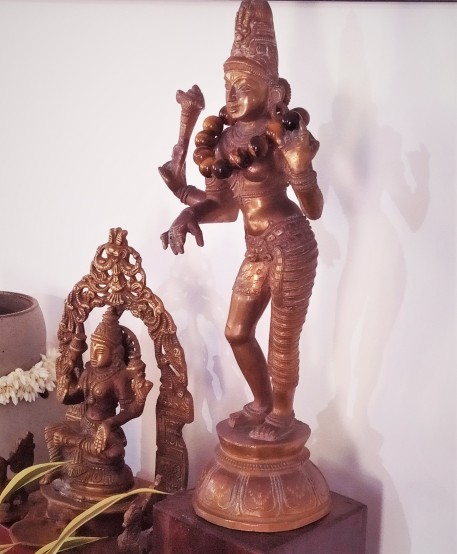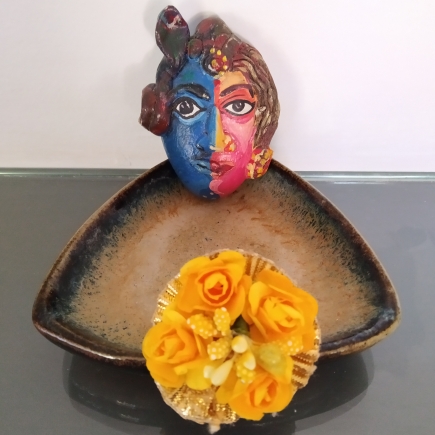The First Time
I clearly remember the first time I walked into what is now the living room of our home. That was a little more than nine years ago.
We had come to see the house for the very first time, and weren’t even sure if we would consider buying it because it had initially seemed out of our budget. But the moment I walked into this empty room with a thick teak-wood shelf all along one wall of the room floating just about three feet below the ceiling, I knew.
I knew that if this room ever became mine, what or rather who would occupy the central place on that beautifully polished shelf.
I could see in my mind’s eye a beautiful bronze Nataraja, the One that expresses “the rapture of the cosmic dance with the profundities behind of the unmoved eternal and infinite bliss.” (Sri Aurobindo, CWSA, 20: 282)

Two and a half years later, that vision came true.
I found that Nataraja, my Nataraja, in an old shop in Kumbakonam, Tamil Nadu. Obviously, He came home with me, and now sits majestically in His spot. Nobody else could have occupied that place. No one. It was always His Home, it was patiently waiting for the Lord.

“O worshipper of the formless Infinite,
Reject not form, what dwells in it is He.
Each finite is that deep Infinity
Enshrining His veiled soul of pure delight.”
(Sri Aurobindo, from the poem Form)

The Lord was waiting too. The Lord always waits…we are the ones who aren’t ready to call Him or receive Him.
A prayer rises silently – May Lord Shiva bless us with greater inner readiness, an intenser aspiration and a wider receptivity.
The Second Time – When He and She Came
Another two years later, I was back in Kumbakonam.

“Without Him I Exist Not, Without Me He is Unmanifest.” (The Mother, CWM, 13: 32)
When I saw my little Ardhanarishvara that evening, I knew exactly the spot that will be His/Her abode in my home.
But I also knew something more. I realised why just a couple of days before I had stood totally transfixed at the Gangaikonda Cholapuram Temple in front of this:

Or why later that day at the majestic Airavatesvara Temple at Darasuram, the unique and magnificent eight-armed form of Ardhanarishvara had left me absolutely awe-struck.
“The gods of Indian sculpture are cosmic beings, embodiments of some great spiritual power, spiritual idea and action, inmost psychic significance, the human form a vehicle of this soul meaning, its outward means of self-expression; everything in the figure, every opportunity it gives, the face, the hands, the posture of the limbs, the poise and turn of the body, every accessory, has to be made instinct with the inner meaning, help it to emerge, carry out the rhythm of the total suggestion, and on the other hand everything is suppressed which would defeat this end, especially all that would mean an insistence on the merely vital or physical, outward or obvious suggestions of the human figure.” (Sri Aurobindo, CWSA 20: 290)
The Ardharishvara form of Divine has always held a special place in my heart. This form has also been an important light in my deeper intellectual quest, helping unfold some deeper truths of Life and Reality.
Man and Woman – Different and Equal
“The idol of Hari-Hara no doubt reveals one of the mysteries of the world; but a greater truth, a deeper mystery is revealed in the idol of Hara-Gauri or Radha-Krishna.” (Nolini Kanta Gupta, About Woman, 1999, p. 5)
The fundamental truth that the Entity which we generally speak of as Divine, Higher Power, or by any other name, while being Transcendent of all Forms perfectly harmonises within the duality of both the man and the woman, of Hara and Gauri, of Shiva and Parvati, of Radha and Krishna, of Rama and Sita, of Vishnu and Lakshmi. As Gupta writes –
“man and woman – purusha and prakriti – are the only duality, there is no other.” (ibid, pp. 4-5).
This is a significant truth revealed to us by our ancient seers and sages, reiterated by Nolini Kanta Gupta in the light of his yogic vision. Equally significant is another truth that is its most natural implication, which the author states thus –
“If any relation exists at all between two different things which seek each other as separate entities for a greater harmony and more perfect realisation – such an interchange between two things is possible only between man and woman. In reality they don’t seem to be two different things but the two halves of one and the same thing – ardhabrgalamiva – as the Upanishad puts it” (p. 5).
And what does the Upanishad say?
“He [the Cosmic Purusha, the Virāj] was not at all happy. Therefore people (still) are not happy when alone. He desired a mate. He became as big as man and wife embracing each other. He parted this very body into two. From that came husband and wife. Therefore, said Yājñavalkya, this (body) is one-half of oneself, like one of the two halves of a split pea. Therefore, this space is indeed filled by the wife. He was united with her. From that men were born.” (Brihadaranyaka Upanishad, 1.4.3 Translation by Swami Madhavananda)

“For we were man and woman from the first,
The twin souls born from one undying fire.”
(Sri Aurobindo, Savitri, p. 614)
These words express in a different form the deeper truths of Existence, Manifestation and Creation as revealed by the Ardhanarishvara form of the Divine. Truths that can guide us to a deeper harmony as we walk on our individual paths.
Man and woman which seem as two distinct entities in Nature, in this relative world, are essentially the manifestation of the same One, two halves of one body, and therefore, in essence one and the same.
It is only in the Relative Existence and for the purpose of creation, that they exist as two separate entities, representing the duality of the Purusha, the Being, and Prakriti, the Nature. The essential Oneness of the Supreme Being of which the two are manifestations remains One in its essence, thus indicating that each of the two entities are complete and whole in themselves, one in essence with the Supreme Oneness.
This implies that man and woman, though complete in themselves, seek a larger fullness and greater harmony when they come together, not to complete each other but to experience the Oneness and Harmony that is essentially part of their separate beings and yet seeks a greater field for its play and expression.
Ardhanarishvara, in Other Forms
For many years, a print of a painting made by the young Delhi-based artist Bindu Popli, titled “You and Me” had found its home on the wall just above the panchaloha Ardhanarishvara. Just a few months back that spot was taken over by a Dasavatara pattachitra to which I had felt particularly drawn when visiting the famous artisan village of Raghurajpur in Odisha.
But the ‘You and Me’ waits for its new home. Because this particular work has always felt to me as the artist’s vision of Ardhanarishvara – a totality that lies beyond duality, a non-duality that is beyond the unity of opposites, a oneness that is beyond the complementarity of the masculine and feminine principles.

“Beyond the manifestation there is no differentiation, that is, there are not two, there is only one. It was at the moment of creation that it became two. But before that it was one, and there was no difference; as it was one, it was only one. There were countless possibilities, but it was one, in fact it was one, and it was only in the creation that it became two. The differentiation is not something eternal and co-existent. It is for the creation, and in fact for the creation of this world only.” (The Mother, CWM, 7: 155)
Another work by the same artist, another vision of Ardhanarishvara, this time inspired a bit by Egyptian art, adorns another wall.

One more Ardhanarishvara by the same artist used to grace my humble home, until a few years back. Maybe it was some plan of the Shiva-Shakti only, but this print was destroyed by a heavy rainstorm which had spilled water inside from an open window.

“Each now was a part of the other’s unity,
The world was but their twin self-finding’s scene
Or their own wedded being’s vaster frame.”
(Sri Aurobindo, Savitri, p. 411)
And Then They Came Once More
This time, in a tiny rupam, but just as marvelous and magnificent in all their glory. It is a beautiful stone painting by the same artist Bindu Popli done for a painting workshop for young children. I was instantly drawn to Them when I visited her studio a couple of years back.
“What Nature is, what God is, what man is can be triumphantly revealed in stone or on canvas.” (Sri Aurobindo, CWSA, 1: 450)



One thought on “When the Gods Came Home”